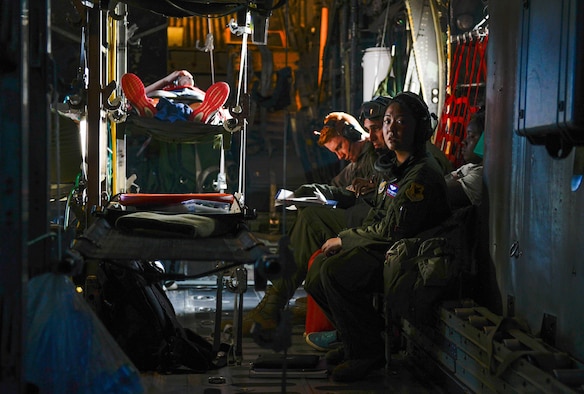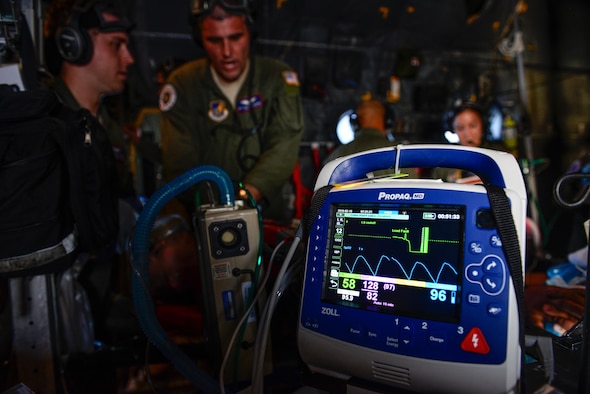
Capt. Melissa Cadorette, a flight nurse with the 18th Aeromedical Evacuation Squadron, listens to crew communications aboard a C-130 Hercules Feb. 15, 2016, during an expeditionary medical support exercise on the island of Rota. Exercise Cope North 16 enhances humanitarian assistance and disaster relief crisis response capabilities between six nations and lays the foundation for regional cooperation during real-world contingencies in the Indo-Asia-Pacific region. (U.S. Air Force photo/Staff Sgt. Alexander W. Riedel)
NORTHERN MARIANA ISLANDS (AFNS) -- Military members from six nations joined together for a humanitarian assistance and disaster relief deployment throughout the region of the Commonwealth of the Northern Mariana Islands Feb. 14-18.
The deployment is part of Cope North 16, a multilateral exercise, including the U.S. Air Force and air forces from across the Indo-Asia-Pacific region.
Col. Brian Toth, the CN16 lead for the U.S. Air Force, said the HA/DR portion enhances regional capabilities to respond to crises and lays the foundation for the expansion of regional cooperation in the face of real-world contingencies.
“Humanitarian assistance and disaster response is an awesome capability we can provide,” Toth said. “The ability to have our forces train together allows us to understand what each part brings to the response and what we can provide together to provide the aid any country in the region may ask for.
“It demonstrates our commitment to working together with our coalition partner countries across the Pacific,” he continued. “We work well together and provide a strong presence — and we know we can rely on each other in a time of need.”
Members from the U.S. Air Force, Navy and Coast Guard -- partnered with the Japan Air Self-Defense Force, Royal Australian Air Force, South Korean air force, Royal New Zealand Air Force and Philippine Air Force -- reacted to a fictional, yet realistic, disaster scenario that was said to affect the Marianas region.
“What we’re focusing on is interoperability, learning from one another how to better respond to disaster situations,” said Sharon Rohde, the CN16 HA/DR lead planner. “It’s about overcoming not only language barriers but differences to how we do business, whether that’s regulatory in nature or based on our understanding of the situation. We open up communication and derive lessons learned to be better prepared in response to disaster.”
The exercise scenario posed a severe impact from a typhoon traversing between the islands of Tinian and Rota, prompting Commonwealth of the Northern Mariana Islands to issue a simulated request for immediate assistance to Guam’s neighboring islands. During the HA/DR response, Guam acted as the hub for all aid efforts. From Guam, crews traveled to two deployed operation centers on “spoke” locations on Rota and Tinian.
Upon notification of the emergency, coalition units responded in a phased approach based on real-world response plans by deploying Royal Australian Air Force combat controllers and Andersen AFB’s 36th Contingency Response Group teams to the islands to survey airfield conditions and establish security for incoming aid flights.
The notional disaster tested the main training objectives of airfield assessment team insertion and substandard airfield operation. Bringing together Airmen from varying Air Force specialties, multilateral contingency teams demonstrated their ability to assess and operate previously inaccessible airfields within 12 hours of notification.
“Contingency response of this type is one of our major functions,” said Lt. Col. Glenn Rineheart, the 36th Mobility Response Squadron commander and exercise mission commander on Rota. “Cope North provides the ability for our Airmen to respond to a foreign location and operate only with those assets which were brought in order to surmount challenges with equipment and personnel and the environment. There is a lot to be gained from operating away from main base.”
After declaring the airfields as safe, contingency teams provided continued communications and aerial port support to allow aircrews to deliver aid. Within hours of the airfield opening, coalition teams began set up of an expeditionary medical support health response team mobile hospital, which stands ready on Guam to deploy to real-world disasters.
Expeditionary medical teams deploy to save lives
From emergency resuscitation to life-preserving surgery, the teams are well-equipped and trained to handle a large variety of possible ailments, yet the priority for medics and nurses lies with triage and initial stabilization of patients.
“The EMEDS-HRT is the first-line response package in the region,” said Staff Sgt. Carlos Rance, a 36th Medical Group medical logistics contracting officer. “We set up the ER tent first, and within a 12-hour period we have a fully operational medical facility that allows our teams to treat more than 300 patients. During this exercise we get the opportunity to not only complete a full setup, from the box up, but doctors and medics also get valuable hands-on experience on what it’s like to operate exclusive with the equipment we carry.”
Receiving a steady stream of typhoon victims who were hypothetically transported from Tinian for medical care, medical technicians and military doctors practiced real-time care procedures on simulated injuries ranging from burn wounds and open fractures to psychological distress and child delivery.
Focused on the patient
When patient condition required a higher echelon of care, a team or flight nurses and medical administrators ensured expedient aeromedical evacuation to a location with a fully functioning hospital.
“The focus of this whole exercise is the patient,” said Australian Flight Lt. Emma J. Dingle, a Royal Australian Air Force flight nurse and CN16 aeromedical evacuation liaison. “It is really important for us to understand how each country functions, so that when we do have to come together for joint disaster responses, we can do it smoothly and effectively and have the best outcome for the people who are in need of help.”
The aeromedical evacuation exercises culminated with a joint rescue event Feb. 17. Coalition search and rescue aviators located simulated downed aircrew in open waters off the coast of Guam and performed a subsequent rotary wing evacuation by U.S. Navy's Helicopter Sea Combat Squadron 25.
Planning success through past lessons learned
For the first time, international HA/DR mission planners gathered during a two-day subject matter exchange and tabletop exercise before kickoff. Airmen from three nations shared their experiences, failures and successes during responses as far ranging as the 2011 tsunami in Japan and the 2015 earthquakes in Nepal.
“This year we added a tabletop exercise, which allowed participants to collaborate before exercising,” Rhode said. “This facilitated discussion about actual disasters that occurred in the Pacific and to hear that firsthand experience from somebody who was actually there and could speak to specific issues that occurred.”
Experts also discussed the integration with civilian agencies that would take important roles in real disaster response situations, such as international civic aviation authorities and USAID coordinators.
“Typically the civilian response agencies can handle most emergencies, even large once,” said Scott Aronson, the senior USAID humanitarian assistance adviser to U.S. Pacific Command. “But the U.S. military has unique abilities that either no one else has or nobody can deploy as quickly. We know, for instance, the CRGs capabilities during an HA/DR event are likely one of the unique abilities we might call on.
“As the lead federal agency for disaster response, we participated to make sure the exercise is realistic from our perspective and to have that face-to-face time with the people and agencies we will see in the field,” Aronson continued. “The biggest challenge is understanding each other’s capabilities and Cope North allows both sides to see what the other brings to the table and how those things work together. Maintaining those relationships is essential.”
Following the tabletop exchange, the teams practiced multinational interoperability during the stressful team building required during mission planning.
“The planning group this year was incredible to see,” said Royal Australian Air Force Squadron Leader Chris O’Byrne, the Australian HA/DR scenario planning lead and exercise mission commander on Tinian. “When you see service members come together and realize that they’re talking about the same thing, while calling it by a different name, and we notice that all the time; it’s an amazing thing to see.”
International interest rises
Because of the resounding successes of HA/DR exercises in the past, an increased number of medical subject matter experts from Bangladesh, Canada, India, Indonesia, Malasia and Thailand visited the HA/DR portion as observers this year to witness operations firsthand and gather information on how to improve or establish their own contingency programs.
“Natural disasters are the ‘when’ not the ‘if’ of contingency scenarios and HA/DR is becoming more and more important and recognized as a critical capability, which is why our partner nations have sent their observers to the tabletop and field training exercises,” O’Byrne said. “During the conduct of the field training, the observers saw the U.S.-led CRG in Rota and the Australian Contingency Response Squadron on Tinian, which will allow them to see how different agencies would react.”
Success in numbers and increased interoperability
Through effective use of its hub-and-spoke relief plan, the coalition teams successfully evacuated approximately 40 patients, moving more than 180 passengers, conducting 30 airdrops and transporting more than 438,600 pounds of cargo from island to island, Rhode said.
“Each year, this exercise has been getting more advanced,” she said. “We are learning more about what types of cargo can go on what types of aircraft or what type of communication capability each country uses. We learn it in the exercise and then when things really kick off, we are not starting from square one. We’re working in the interest of saving lives and no one country can do it all themselves, so it’s a lot easier to get on board and figure out the problem together.”
Currently ongoing, this year marks the 87th iteration of exercise Cope North, which includes a long-standing, multinational HA/DR event designed to increase interoperability and develop a synergistic disaster response capability between the U.S. Air Force, Japan Air-Self Defense Force and Royal Australian Air Force. The second half of Cope North will shift the focus to air combat training, which will include air-to-air and air-to-ground combat and large force employment training.

Staff Sgt. Matthew Flowers, an aeromedical evacuation technician with the 18th Aeromedical Evacuation Squadron, performs simulated CPR aboard a C-130 Hercules Feb. 15, 2016, during an expeditionary medical support exercise above the Pacific Ocean near Guam. Exercise Cope North 16 enhances humanitarian assistance and disaster relief crisis response capabilities between six nations and lays the foundation for regional cooperation during real-world contingencies in the Indo-Asia-Pacific region. (U.S. Air Force photo/Staff Sgt. Alexander W. Riedel)
http://www.af.mil/News/ArticleDisplay/tabid/223/Article/671624/pacific-partners-practice-humanitarian-assistance-during-cope-north.aspx

No comments:
Post a Comment
Note: Only a member of this blog may post a comment.